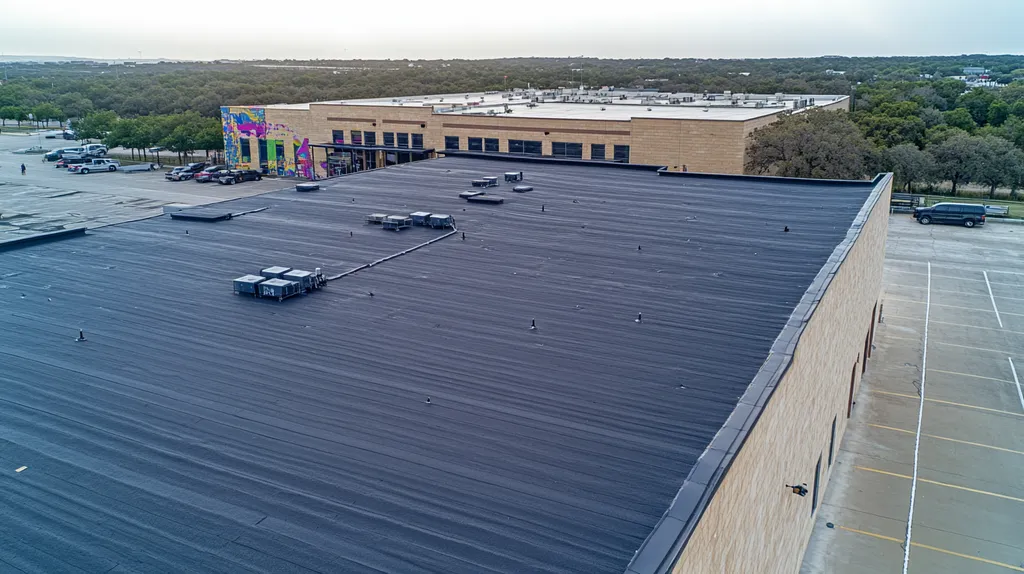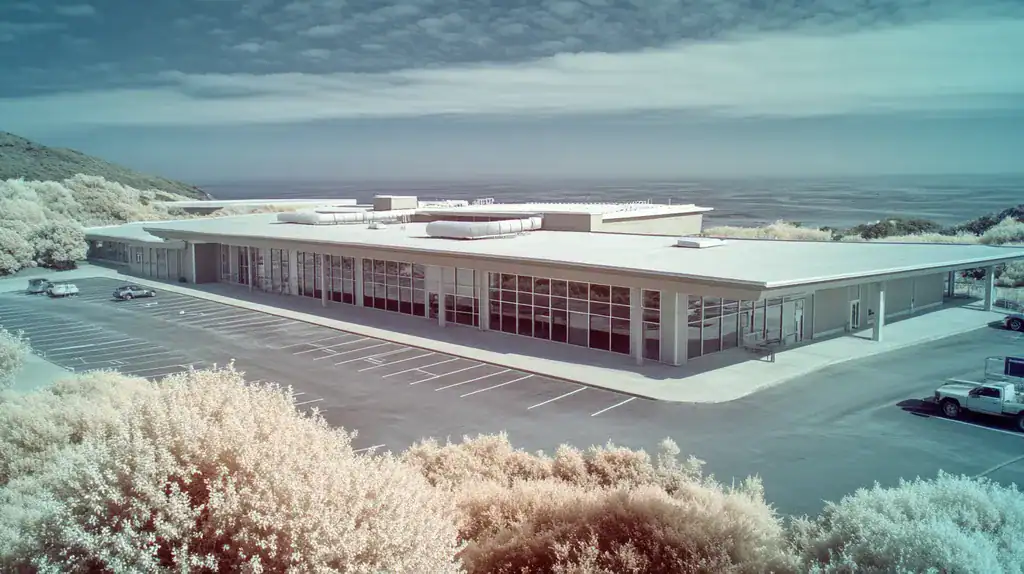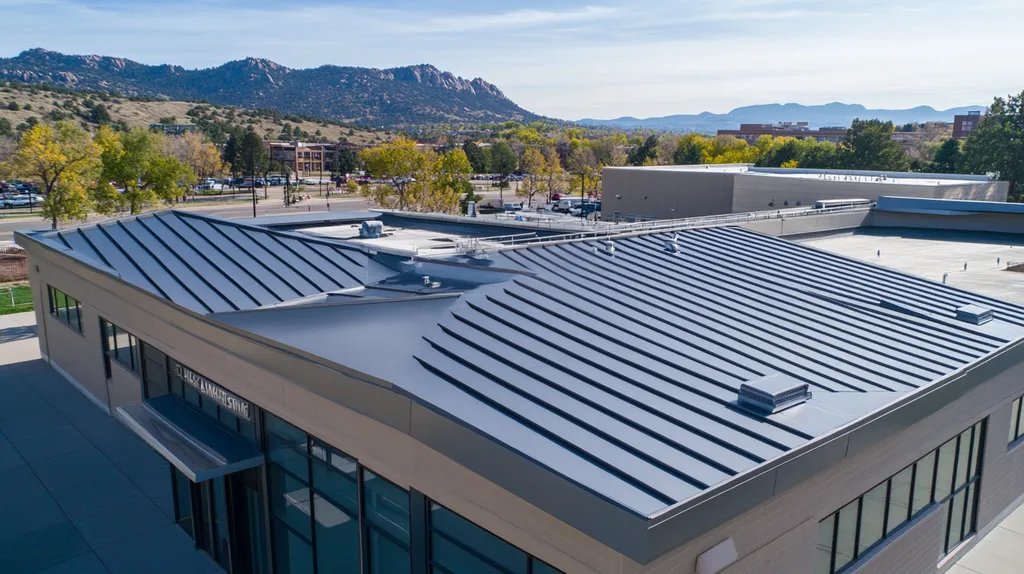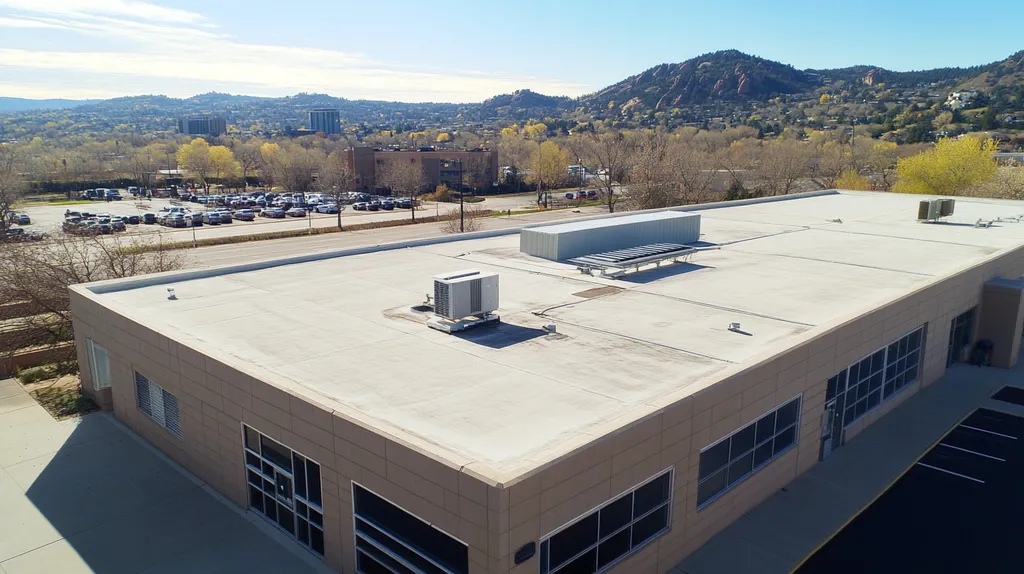Every year, industrial facilities lose millions of dollars to premature roof failures, with the average replacement occurring 7-10 years before the expected end of service life.
From extreme weather events to chemical exposure and structural stress, multiple critical factors determine whether a roofing system will last 5 years or 30 years.
Understanding these key variables – and how they interact – enables facility managers to make informed decisions that protect their buildings while maximizing their roofing investment.
This comprehensive guide examines the essential elements affecting industrial roof longevity, from material selection and installation quality to maintenance protocols and environmental conditions.
SECTION 1: THE BASICS EXPLAINED
Industrial roofing systems represent one of the most significant investments in commercial property management, with premature failures potentially costing millions in repairs and business disruption. Recent industry data shows that water damage from roof failures averages $2.7 million per incident in large industrial facilities. Understanding the factors that influence roof longevity isn’t just about maintenance—it’s about protecting your entire operation from catastrophic failure.
What It Is (In Plain Language)
An industrial roofing system is more than just a cover for your building—it’s an integrated network of components working together to protect your facility. These systems include the primary membrane or metal covering, insulation layers, drainage systems, and structural supports that distribute weight and manage stress.
The U.S. General Services Administration’s P100 Facilities Standards mandate specific requirements for roofing durability, safety, and performance benchmarks. Any alternative solutions must demonstrate superior effectiveness in ensuring long-term facility protection. (source: GSA P100 Facilities Standards)
Modern industrial roofing typically falls into three main categories: single-ply membranes (TPO, EPDM, PVC), built-up roofing systems (BUR), and metal roofing. Each system offers distinct advantages depending on your facility’s specific needs, climate conditions, and operational requirements.
Why It Matters (To Your Building)
The condition of your roof directly impacts operational costs across multiple areas. Energy efficiency can vary by up to 40% between well-maintained and deteriorating roof systems, significantly affecting heating and cooling expenses.
Roof performance influences insurance premiums and coverage terms. Many insurers now require documented roof maintenance programs and regular inspections to maintain coverage, particularly in regions prone to severe weather events.
Asset preservation is another critical factor. A compromised roof can lead to cascading failures affecting everything from structural integrity to equipment functionality. Even minor leaks can create conditions for mold growth, compromising indoor air quality and worker safety.
How It Works
Industrial roofing systems function through multiple layers working in concert. The outer layer provides weather resistance while underlying components manage thermal movement, moisture control, and structural loads.
Proper installation ensures these components work together effectively. For example, expansion joints accommodate building movement, while properly designed drainage prevents water accumulation that could compromise structural integrity.
Environmental factors play a crucial role in system performance. UV exposure, temperature fluctuations, chemical exposure from industrial processes, and local weather patterns all influence how different roofing components age and perform.
Regular inspections and maintenance are essential for identifying potential issues before they escalate. This includes examining seams, flashings, drainage systems, and supporting structures for signs of wear or damage.
SECTION 2: PRACTICAL APPLICATIONS
Industrial roofing decisions carry significant operational and financial implications, with the average facility losing up to $3 per square foot annually due to inefficient roofing choices. Poor system selection and improper maintenance can accelerate deterioration, leading to premature failure and costly replacements. Understanding practical applications helps facility managers optimize their roofing investments while ensuring maximum protection for their operations.
Common Uses & Examples
Manufacturing facilities typically require robust systems that can withstand chemical exposure, high temperatures, and heavy equipment vibrations. TPO and EPDM systems excel in these environments due to their chemical resistance and durability.
Warehouse and distribution centers often benefit from reflective metal or white membrane roofing systems that reduce cooling costs. These facilities usually require minimal roof penetrations, making seamless systems particularly effective.
Food processing plants demand roofing systems that prevent condensation and maintain strict hygiene standards. PVC membranes with hot-air welded seams provide excellent protection against bacterial growth and moisture infiltration.
Cold storage facilities require specialized vapor barriers and increased insulation values. These buildings need careful attention to thermal bridges and air barriers to prevent condensation issues.
When You Need It Most
Many facilities problems arise from extreme environmental conditions and insufficient maintenance funding. Older buildings particularly face efficiency challenges that can significantly impact operational costs.
Regular maintenance staffing, proper training, and effective management are essential to prevent premature deterioration. Environmental stressors can rapidly accelerate system degradation without proper oversight. (source: National Center for Education Statistics)
Pre-winter inspections are crucial to identify potential weak points before snow loads stress the system. Similarly, spring assessments help detect damage from winter weather patterns.
Emergency response planning should include roof inspection protocols following severe weather events. Quick identification of storm damage can prevent minor issues from escalating into major failures.
Interactions With Other Systems
Roofing systems directly impact HVAC efficiency through heat gain and loss. Proper insulation and reflective surfaces can reduce cooling loads by up to 15% in warm climates.
Structural elements must accommodate both roofing system weight and anticipated loads. Changes in building use or equipment placement often require reassessment of roofing system compatibility.
Lightning protection systems require proper integration with roofing components to maintain warranty coverage. Improper installation can create entry points for moisture and compromise system integrity.
Drainage systems must work in concert with roof slope and material choices. Poor drainage coordination often leads to ponding water and accelerated membrane degradation.
Building automation systems can help monitor roof performance through moisture sensors and thermal scanning. This integration enables predictive maintenance and early problem detection.
SECTION 3: KEY TERMINOLOGY DECODED
Misunderstanding roofing terminology costs facility owners millions annually in preventable damage and unnecessary replacements. Recent industry surveys show that 67% of commercial property managers misinterpret critical roofing specifications, leading to improper material selection and maintenance errors. Clear understanding of technical terms, industry standards, and measurement specifications forms the foundation for effective roof management and cost control.
Essential Terms Explained
Thermal movement describes how roofing materials expand and contract with temperature changes. Understanding this concept is crucial for proper material selection and installation methods to prevent premature failure.
Vapor barriers control moisture migration through the roofing assembly. Proper specification and installation of these components prevent condensation that can degrade insulation performance and promote corrosion.
Load capacity refers to the maximum weight a roof structure can safely support. This includes both dead loads (permanent weight) and live loads (temporary weight from snow, equipment, or maintenance activities).
Drainage systems include gutters, downspouts, and internal drains that remove water from the roof surface. Proper sizing and placement prevent ponding water that can lead to membrane degradation and structural issues.
Industry Jargon Translated
The term “mil thickness” measures membrane material in thousandths of an inch. This measurement directly impacts durability, with higher numbers indicating more robust protection against weathering and damage.
Environmental stress factors significantly influence roof performance across different building types and climate zones. Proper understanding of these stressors enables more effective maintenance planning and system selection. (source: National Center for Education Statistics)
“Cool roof” ratings indicate a material’s ability to reflect solar radiation and release absorbed heat. Higher ratings translate to reduced cooling costs and extended membrane life in warm climates.
Wind uplift resistance categories define a system’s ability to withstand specific wind pressures. These ratings must match local building codes and site-specific conditions to ensure proper protection.
Measurement & Units Simplified
R-value measures thermal resistance, with higher numbers indicating better insulation performance. Climate zone and building use determine optimal R-values for energy efficiency.
Slope measurements use ratio notation, such as 1:12, indicating rise over run. This measurement helps determine appropriate drainage solutions and material compatibility.
Fire ratings classify roof assemblies by their resistance to flame spread. Class A provides the highest protection, while Class C offers minimum code-required resistance.
Warranty terms specify coverage duration and conditions. Standard warranties typically range from 10 to 30 years, with specific maintenance requirements to maintain coverage.
SECTION 4: DECISION FACTORS
Industrial roofing decisions represent some of the most consequential choices facility managers face, with poor selections leading to premature failures costing an average of $4-7 per square foot in emergency repairs. Recent data shows that 40% of industrial roof replacements occur years before their intended lifespan due to inadequate initial decision-making. Understanding the interplay between costs, performance requirements, and durability factors helps prevent costly mistakes while maximizing return on investment.
Cost Considerations
Initial investment represents only 15-20% of a roof’s total lifecycle cost. Labor, maintenance, repairs, and potential business disruption comprise the majority of long-term expenses.
Energy efficiency plays a crucial role in cost calculations. High-performance systems can reduce HVAC loads by up to 30%, though they typically require greater upfront investment.
Warranty terms significantly impact long-term expenses. Premium systems often include longer coverage periods and fewer exclusions, providing better protection against unexpected costs.
Installation quality directly affects maintenance expenses. Professional installation may cost more initially but prevents costly repairs and extends system lifespan considerably.
Performance Trade-offs
Different roofing systems excel in specific environments. Single-ply membranes offer excellent UV resistance but may require additional reinforcement in areas with high foot traffic.
Chemical exposure tolerance varies significantly between systems. Some materials resist industrial emissions effectively but show vulnerability to certain cleaning solutions or process exhaust.
Wind uplift resistance often conflicts with installation ease. Systems with superior wind performance typically require more complex installation procedures and higher skilled labor.
Thermal movement accommodation varies between materials. Systems with superior flexibility may sacrifice puncture resistance or durability in other areas.
Lifespan & Durability Factors
Material quality fundamentally determines system longevity. Industrial roofing systems typically last between 15-70 years, with higher-quality materials offering superior durability and extended lifespans. (source: Cloud Roofing)
Environmental exposure significantly impacts durability. UV radiation, temperature fluctuations, and precipitation patterns can accelerate wear on improperly specified systems.
Maintenance practices directly affect service life. Regular inspections and prompt repairs can extend roof lifespan by 25-40% compared to reactive maintenance approaches.
Structural integrity of the underlying deck influences system performance. Proper evaluation of existing conditions helps prevent premature failure due to substrate issues.
Installation method quality often outweighs material selection in determining longevity. Poor installation techniques can reduce expected lifespan by up to 50% regardless of material quality.
SECTION 5: COMMON CHALLENGES
Industrial roofing failures cost facility owners over $3.5 billion annually in repairs, replacements, and operational disruptions. Studies indicate that 85% of these failures stem from predictable and preventable issues that go unaddressed. Understanding and proactively managing common roofing challenges can mean the difference between a system that fails prematurely and one that delivers its full expected lifespan.
Frequent Problems & Solutions
Water infiltration remains the leading cause of industrial roof failure, with improper flashing details accounting for 47% of all documented leaks. Proper installation and regular inspection of roof penetrations, particularly around HVAC units and pipe penetrations, can prevent most water-related issues.
Membrane deterioration from UV exposure and chemical contamination poses another significant threat. Installing appropriate protective coatings and implementing strict protocols for handling roof-damaging chemicals can extend membrane life significantly.
Poor drainage design leads to ponding water, which can add thousands of pounds of unnecessary weight to roof structures. Installing additional drainage points and maintaining clear water paths prevents structural stress and membrane degradation.
Inadequate ventilation and insulation often create condensation issues that compromise both roof performance and indoor air quality. Upgrading ventilation systems and properly sealing air barriers helps maintain proper moisture control.
Warning Signs To Watch For
Interior staining and dripping don’t always indicate the leak’s true location, as water can travel significant distances before appearing. Implementing infrared scanning during inspections helps pinpoint moisture intrusion points accurately.
Membrane seam separation, particularly around roof penetrations and perimeter details, indicates potential system failure. Regular inspection of these high-stress areas helps identify problems before water infiltration occurs.
Surface blistering and ridging suggest underlying moisture or installation problems that require immediate attention. These visible defects often precede more serious system failures by several months.
Unexplained increases in energy costs may indicate insulation saturation or compromised roof system performance. Tracking energy usage patterns helps identify developing problems before visible damage appears.
Preventative Approaches
Cloud Roofing notes that commercial roofing systems can last between 15-70 years, with material quality and climate conditions serving as major influences on longevity. (source: Cloud Roofing)
Implementing a documented maintenance program with scheduled inspections reduces emergency repairs by up to 60%. This should include detailed documentation of all roof work and regular assessment of high-risk areas.
Creating designated roof access paths and equipment maintenance zones prevents random foot traffic damage. Installing walkway pads and implementing strict access protocols protects vulnerable roof surfaces.
Developing emergency response protocols for severe weather events ensures rapid assessment and repair of storm damage. This includes maintaining relationships with qualified contractors who can respond quickly when needed.
Training maintenance staff in proper roof system care and inspection techniques maximizes the effectiveness of preventative programs. Regular updates to training materials keep staff current with evolving best practices.
SECTION 6: NEXT STEPS & RESOURCES
Industrial roofing decisions represent substantial financial commitments, with improper planning leading to an average 40% reduction in system lifespan and millions in premature replacement costs. Recent data shows that facilities following comprehensive assessment and maintenance protocols achieve twice the average roof longevity compared to those making decisions without proper guidance. Understanding available resources and following established standards helps facility managers maximize their roofing investments while ensuring optimal protection.
Questions To Ask Providers
Start by requesting detailed project portfolios featuring installations similar to your facility type and scale. This helps verify experience with specific environmental challenges and performance requirements relevant to your operation.
Demand comprehensive material specifications including chemical resistance ratings, thermal performance data, and wind uplift capabilities. Understanding these technical aspects ensures proper system selection for your facility’s specific demands.
Review proposed maintenance protocols and warranty terms in detail. Quality providers offer clear documentation of inspection schedules, maintenance requirements, and specific conditions that could void warranty coverage.
Request references from facilities where installations have performed for at least five years. Long-term performance data provides valuable insights into system durability and provider reliability.
Verify contractor certifications from major manufacturers and industry organizations. These credentials indicate commitment to quality installation practices and ongoing education in current technologies.
Industry Standards & Guidelines
The U.S. General Services Administration’s P100 Facilities Standards establish mandatory criteria for roofing system quality, durability, and safety. These guidelines ensure roofing installations meet rigorous performance benchmarks while maintaining long-term durability. (source: GSA P100 Facilities Standards)
Familiarize yourself with ASTM testing standards for your selected roofing materials. These specifications provide objective measures for evaluating material quality and performance capabilities.
Review local building codes and insurance requirements affecting roof system selection. Many jurisdictions have specific requirements for wind resistance, fire ratings, and energy efficiency.
Understand industry-standard warranty terms and coverage limitations. This knowledge helps negotiate better protection against premature system failure and installation defects.
Further Learning Simplified
Access educational resources through major manufacturers and industry associations. Many offer free technical bulletins, installation guides, and maintenance recommendations specific to different system types.
Participate in professional development programs focused on roofing technology and maintenance. These courses provide valuable insights into emerging materials and best practices.
Connect with local roofing associations to access regional expertise and contractor recommendations. These organizations often maintain databases of qualified professionals and installation case studies.
Subscribe to industry publications focusing on commercial roofing advances. Regular updates help track evolving technologies and maintenance strategies that can extend roof longevity.
Document and share knowledge gained through your facility’s roofing experiences. Building an institutional knowledge base helps improve future decision-making and maintenance practices.
The Bottom Line
With industrial roof replacements averaging $750,000 and rising 12% annually, facility managers cannot afford to ignore the critical factors affecting roofing system longevity.
Material selection, installation quality, maintenance protocols, and environmental conditions work together to determine whether a roof will fail prematurely or reach its full potential lifespan.
Understanding these key variables – and implementing proper specifications, inspection schedules, and preventative maintenance – can extend roof life by 40% while reducing lifetime costs by up to 60%.
The difference between a 10-year problem roof and a 30-year high-performance system often comes down to informed decision-making and proactive management in these critical areas.
Facility managers who master these fundamentals protect not just their roofs, but their entire operations from costly disruptions and premature capital expenditures.
FREQUENTLY ASKED QUESTIONS
Q. What is the lifespan of a commercial roof system?
A. The lifespan of a commercial roof system varies based on materials used, installation quality, and maintenance practices. Generally, these systems can last anywhere from 15 to 70 years, with higher-quality materials yielding longer service lives. Regular inspections and prompt repairs are crucial for maximizing longevity.
Q. How do I choose the right industrial roof system?
A. Choosing the right industrial roof system involves assessing your facility’s specific needs, including climate, building use, and potential hazards. Evaluate different materials based on their performance characteristics, such as resistance to chemicals and weather conditions. Consulting with roofing experts can provide insights tailored to your operation.
Q. What are common signs of roof problems on commercial roofs?
A. Common signs of roof problems include interior water stains, visible membrane damage, and unusual energy cost increases. Additionally, monitoring roof seams and flashings for separation can help catch issues early. Addressing these warning signs promptly can prevent more significant damage and costly repairs.
Q. What maintenance practices extend industrial roof lifespan?
A. Regular inspections, routine cleaning of drainage systems, and timely repairs are key maintenance practices. Creating a documented maintenance schedule can help address minor issues before they escalate. Training your staff on proper inspection techniques can also improve the lifespan of your roofing system.
Q. How do environmental conditions affect commercial roof durability?
A. Environmental conditions like UV exposure, temperature fluctuations, and precipitation significantly influence roof durability. For instance, excessive heat can accelerate material degradation, while moisture can lead to mold and corrosion. Understanding your local climate helps in selecting the most suitable roofing materials and maintenance practices.
Q. Why is professional installation important for industrial roofing?
A. Professional installation is crucial because it ensures that the roofing system is set up correctly according to manufacturer specifications. Improper installation can significantly reduce the lifespan of the roof and lead to issues like leaks and structural failures. A qualified installer can also tailor the approach based on specific facility needs.
Q. What resources can I use for choosing my commercial roof system?
A. You can use resources like industry publications, manufacturer guidelines, and professional roofing associations for information. Consulting with roofing experts and utilizing technical bulletins can also offer valuable insights. Additionally, attending workshops and training sessions can enhance your knowledge on the latest materials and technologies.










